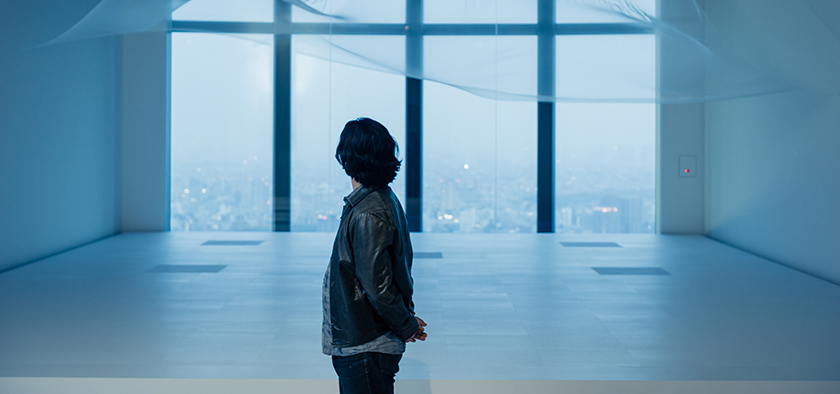
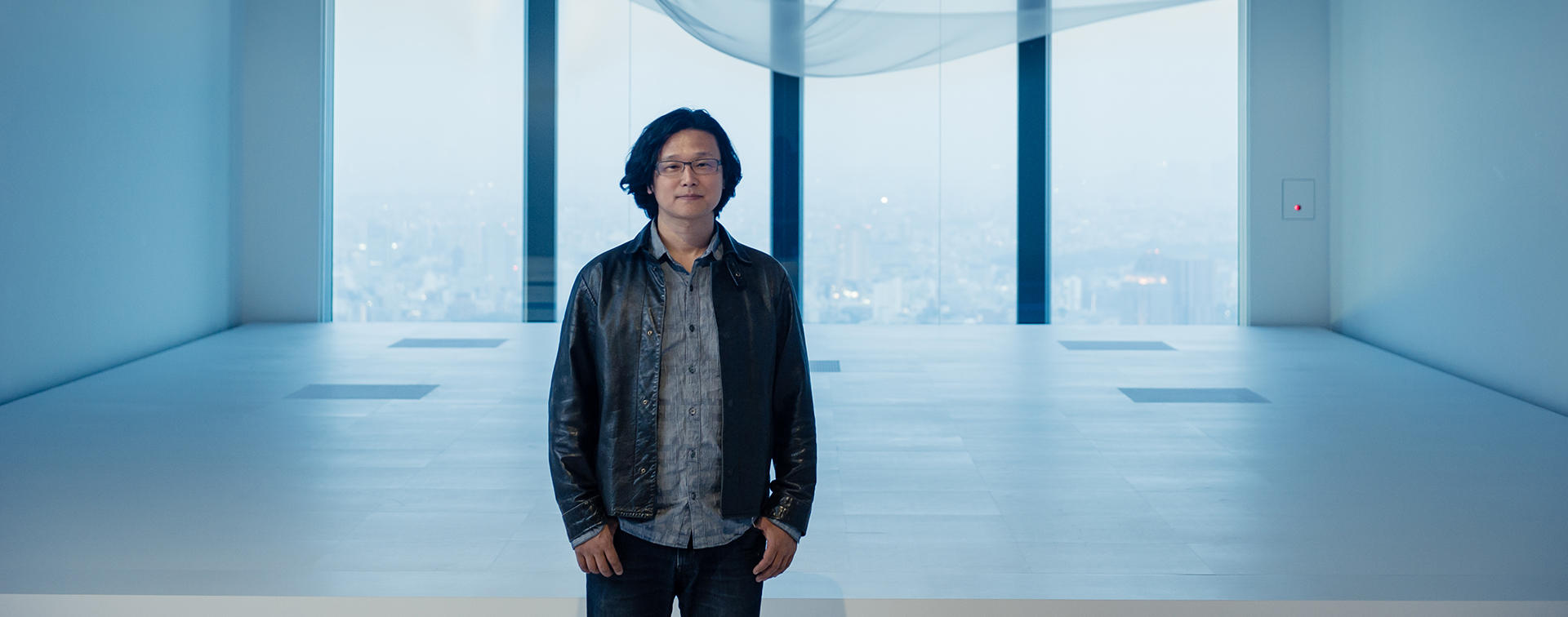

Ideas for Roppongi, an area which has almost everything
A performance to bring Roppongi to a halt A space for artists, and “Tent Night”
Artist Shinji Ohmaki is known for creating dynamic works that transport the viewer out of the sense of everyday ordinariness. His "Echoes" series are rooms where people can walk around, viewing the flowers painted on the expanse of walls and floors. "Memorial Rebirth" is a large-scale work of performance art where countless bubbles are created. In this interview, Ohmaki talked about the future of Roppongi, public art and residential spaces. We began by asking him what kind of things he thinks Roppongi lacks. He responded by asking, "Indeed, can you think of anything that Roppongi doesn't already have?"
Quietness and the demise of Roppongi
Roppongi is filled with so many people and all kinds of things. But if you think about it, there must be things that it doesn't have. At the end of an era, a city has accumulated so many things that there is almost nothing it lacks. But once it has become saturated, a city withers quickly, as fast as a falling tide. For example, the shopping district near the station in my hometown in Gifu shut down after about 70 years. Well, it's not completely shut down, but most of the shops have closed, and the place has virtually stopped functioning as a town.
So when a city has nothing it lacks, it ends. In Roppongi, there are many art events and art museums, and people can enjoy everything from music to shopping. A moment ago, when I asked what kind of things Roppongi doesn't already have, someone said, "It lacks quietness." It's true that Roppongi is always bustling. There might be people who wish that Roppongi will become quiet, but maybe that might the ultimate factor that would saturate Roppongi. The very act of trying to bring quietness to Roppongi could lead to the collapse of everything.
Humans are bored, ambiguous beings
Incidentally, there's a work of mine called Liminal Air Space-Time currently being shown at the "Simple Forms- Contemplating Beauty" exhibition at the Mori Art Museum; I'm afraid that work has brought a form of quietness to Roppongi. (laughs)
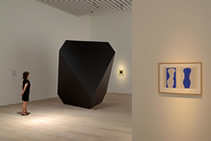
Simple Forms - Contemplating Beauty
The first joint exhibition by Centre Pompidou-Metz and Fondation d'entreprise Hermès on tour in Japan. On display are about 130 works of "simple forms" from prehistoric stone tools to innovative installations by contemporary artists. Held at the Mori Art Museum until July 5, 2015.
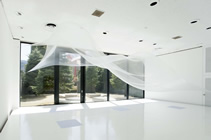
Liminal Air Space-Time
An installation consisting of a cloth which moves up and down by wafts of air sent from the floor. The work creates a dimension of time and space that is different from everyday life and is intended to jolt the sensations of the viewer. Photo is of the "Proof of Existence" exhibition held at the Hakone Open-Air Museum in 2012. Photo by Satoshi Nagare.
The work consists of a white cloth which at first seems to be just moving slowly, but in the end, the viewer cannot tell for sure whether it really is cloth. The work becomes a totally different creature in the nighttime from the daytime. My aim was to create a dimension of vacant, wafting time and to invite the viewer to question whether the things we see are real - to rethink our assumptions. We place trust in physical matter, but things are not always what they appear to be, and our trust can be broken.
We know a lot about ourselves, but few of us know exactly what kind of state we are in when we are sleeping at night. There are hours in the day that are unknown to us. There are unknown zones to all physical things. We think we are alive when we are sleeping, but maybe sleep is death. We are living in an age where people assume they have knowledge about so many things, but in fact we often don't even know what we are looking at. Humans are like that - we are beings of ennui and ambiguousness.
With each rise and fall of the curtain, Tokyo is born anew
The cloth is like a stage curtain. The curtain gently rises, swayed by the waves of energy from the city, and then it falls as if covering everything. Then the curtain rises again, as if for a new stage. The world seems to be ending and yet a new world is born. Every ten minutes that the cloth rises and falls, the old is replaced with the new, and it's as if Tokyo, the center of Japan, is being reborn every time.
I released this work the year after the Great East Japan Earthquake. I wanted to make something to express the fact that the world continues to be born anew every day. That's why at the Hakone Open-Air Museum where the exhibition was held, I had the work placed in a room that had a view of the outdoor landscape. At the current Mori Art Museum exhibition, the work is in front of a window which has a panoramic view of the streets of Tokyo.
Perhaps in the future, the scenery we see today may no longer exist. The streets of Tokyo could end, but the end is also the beginning. So in a sense, this work expresses the good and the bad factors, as well as the irony of it all.

A performance to make Roppongi temporarily stop
I set up my first studio in the business district of Okachimachi, and then moved to the downtown shopping district of Kita-Senju. I'm now building a house at the tip of Miura Peninsula. Roppongi is an area that is most remote from me. It seems to be an area with energy always filling every part of it. It's like a cup that doesn't overflow but is constantly being filled with water. I've never lived in Roppongi so I wouldn't know, but I have the feeling that's it's a place where the energy never stops flowing.
But perhaps everything did stop for a moment when the earthquake struck. I think everyone must have been afraid then that it was all going to end. At the Roppongi Art Night 2015, a project was launched for relighting Tatsuo Miyajima-san's Counter Void. That work of public art has been turned off ever since the earthquake disaster. I feel that it's best to have the landscape restored to how it used to be; if Counter Void were lighted again, I think it would help Roppongi recover some of its former vitality.

Relight Project
A project aimed to relight the work of public art "Counter Void" in Keyakizaka Slope whose lights have not been turned back on since the Great East Japan Earthquake. During Roppongi Art Night 2015, a large notice of an unfinished sentence reading "3.11 is" was put up with a black panel in the place where the last words should be. At a workshop, visitors wrote their suggestions for completing the sentence.
I'm not sure how we could actually do this, but it would be nice to do a performance to make Roppongi stand still. For example, all the lights in Roppongi could be switched off for one minute. Then the lights, together with the lights of the Counter Void, could be switched on again. People want to forget the bad things; forgetting is necessary to order to go on with life. But it was because of that sense of helplessness which we experienced during the disaster that made us resolve to pick up the pieces and start doing whatever we could do. So I think it's important for us now to reflect on that moment when time came to a halt.
Works that more like stage performances than artworks
Artworks such as paintings and sculptures are embodiments of the inner side of artists, but the things I make are more like stage performances. Miyajima-san's Counter Void is similar in that way. While there are no performers, it's still like a stage. The people who come to look at my creations move about as they like and essentially do the performance. I think it's a lovely thing if my works could become a part of everyday life.
The scale of my works has gradually become larger: they've become so big that people now tell me that they're impossible to implement... The largest work so far has been "Echoes-Infinity" which was shown in Shanghai in a place with floor space of around 550 square meters. That was more than double the size of the works I'd done till then and I had only half the usual time to complete it. I just told myself I would get it done, and I continued painting for a week without sleeping properly. Although it's an installation that is meant for people to walk on, I couldn't bring myself to immediately step on the pictures I'd just painted. But the visitors were running around and making lines on the paintings with their feet, and I was thinking, "Stop! Please walk normally!" (laughs)
Always thinking of the future that lies ahead
"Liminal Air-core-" is a work I made for Art Setouchi and consists of gate-like pillars that evoke a color chart. A color chart is something you photograph when taking photos so that you can refer to it later to adjust the colors - it's a benchmark you refer to. This work expresses the concept of a standard that people can keep referring to when the landscapes and our surroundings change in the future.
Visitors might take pictures in front of the gates, making V-signs with their hands and saying "peace!" Then 30, 50, or 100 years later, when all the photos that have been taken are gathered, people will be able to see how the landscape has changed. Are they going to say, "It's nice that nothing has changed," or will they say, "Aah, the people of the past were looking at a different landscape?" I made the work hoping it will ultimately be useful for that kind of reference. For me what is important is what lies ahead of the people making the "peace" pose; the future is always on my mind when I make my works.
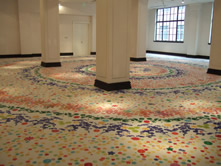
Echoes - Infinity
A work from Ohmaki's "Echoes" series which is among his representative art installations. Flowers are painted all over a white felt carpet with food colorings and pigments used in "Nihonga" (Japanese-style) paintings. After the flowers become smudged from people walking over them, more flowers are painted.
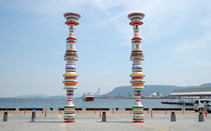
Liminal Air-core-
Two colorful 8-meter-high pillars installed at the Port of Takamatsu. Some parts of the pillars are mirrors which reflect the surrounding landscape. The installation looks different according to the standpoint of the viewer and the hour of the day. The work was exhibited for Art Setouchi 2010. Photo by Tetsuo Ito.
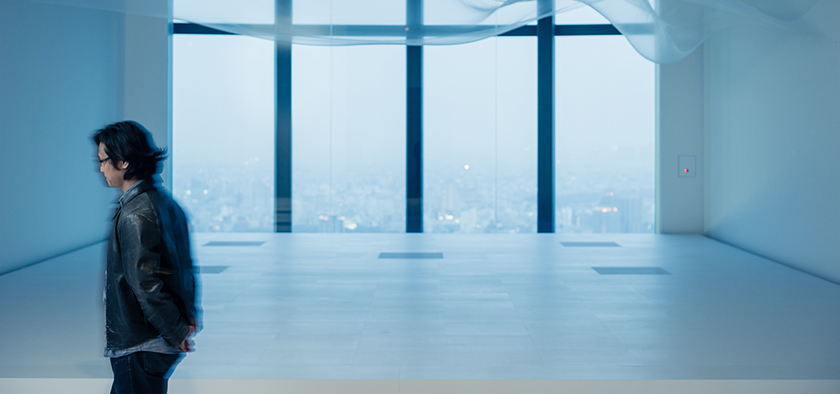
Doubts about the dream town of architects
I have no personal requests to make regarding the future of Roppongi. However, aside from the performance I mentioned earlier, there are some things I would like to do here. One would be to make a new building or space. It seems to me that in Japan, while architects have gained a strong influence, people tend to look at the works of artists as decorative things. I feel that architects and artists could collaborate more to change the environment. The Bird's Nest stadium that Ai Weiwei and Herzog & de Meuron designed for the Beijing Olympics - that whole building is like a sculpture, isn't it?
Perhaps architects need to change the way they think about things such as public art. Artwork in the streets has become quite common now, but there seems to be a preference for restrained designs, and a dislike for works that are colorful and assertive. Maybe the reason is that architects don't want things that get in the way of their architecture. It makes me wonder what architects think of as the ideal town. Maybe I'm being harsh, but it seems to me sometimes that the architects' dream town is a ghost town where there are no people and no lived-in feel.
A sculpture to live in - a space for artists
I get the feeling nowadays that people are just flowing in and out of buildings, and the buildings - however nice they may be -are ultimately spurning the people. So I would like to make an art space that doesn't spurn people but welcome them; more ambitiously, I would like to create a sculpture-like architecture for people to live in. Perhaps I'm thinking of something similar to the space designed by Shusaku Arakawa - a place that eventually transcends people.
It would be space made not by architects, but by artists. All the walls could be decorated with street painting, and could be later repainted. It could be rented out for a month and dancers could live there and use it anyway they like. Performances could be given and the place could be used in unique ways, becoming a place for creativity and fun. We could collaborate with specialists from all kinds of genres; by continuing to make experiments, perhaps we would be able to create a space that is truly for people.
When people come to Roppongi with their children, there are no places where the children can be left to play. So perhaps we could do something about it by collaborating with housewives. Or we could do something about the lack of old people in Roppongi by joining forces with granddads and grandmas. Maybe if we did that, the old people who go to Sugamo now might start coming to Roppongi one day. We could hold workshops and lectures and invite everyone to think about what kind of place they would like to create. I dream of such an experimental space of art. Maybe we don't need to use the word "art" for it. (laughs)
"Roppongi Tent Night" and boundary zones
Another idea I have, which is very different from a space for living and playing, is for people to spend the night in tents in the streets. We've never seen people put up tents in Roppongi, have we? So we could have Tent Night just like we have Art Night. Tent villages could be set up in the Grass Square in Tokyo Midtown, or under the Maman sculpture in Roppongi Hills, and we could make curry and have camp fires.
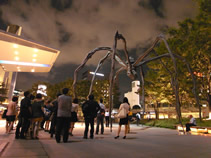
Maman
A 10-meter-high sculpture of a spider installed at 66 Plaza near the entrance of Roppongi Hills Mori Tower. Themed on motherhood, the huge spider carries eggs made of marble in its womb. The work of public art is by world renowned sculptor Louise Bourgeois.
We don't see many homeless people in the streets any more, but in the past, there used to be empty areas in a town. Danpei Tange in "Ashita no Joe (Champion Joe)" built a gym on the riverside beneath a bridge. I think those kind of empty areas were like the last boundary zones for people. But we did away with such places, placing value on things that look good on the surface, and we now seem to live in a more restrictive world. That's why we need "Tent Night." And in the case of another disaster, whose possibility we cannot deny, we might have to live in tents.
Ambiguous zones that belong to both worlds
Boundary zones are always on my mind when I make my works. A performance to bring Roppongi to a halt is about the boundary between life and death. The space for artists is about the boundary between art and architecture, and the same can be said for Tent Night. On hearing the word "boundary", people might think of a straight line, but I imagine boundaries as having depth. It's like atmosphere; from here to there is the planet earth, and from here to there is space that lies beyond earth. The boundaries are ambiguous and wavering; they are not lines but zones.
On a Noh stage, there is a painting of a pine tree on the backdrop called "Yogo no matsu" (Yogo pine tree). "Yogo" means the appearance of a god. The god does not belong solely to the other side (the world of deities) or solely to this side (the world of humans) but belongs to both at the same time. Existing in an ambiguous zone, the god gently exerts influence to sway people. Creating similar circumstances in artwork, space, and in the streets is what interests me most.
Editor's thoughts
Ohmaki-san laughingly said he had "just been talking about silly things" but we were impressed by his spontaneous ideas which seemed so feasible. The proposal for putting up tents in Roppongi was also one made by Junji Tanigawa-san, although Tanigawa-san was thinking along slightly different lines. The interview can be read here:http://6mirai.tokyo-midtown.com/en/interview/48/(edit_kentaro inoue)


















